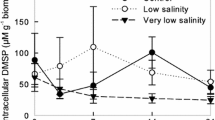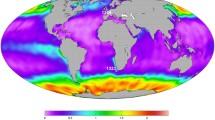Abstract
The effect of salinity, pH, and dissolved inorganic carbon (TCO2) on growth and survival of three Arctic sea ice algal species, two diatoms (Fragilariopsis nana and Fragilariopsis sp.), and one species of chlorophyte (Chlamydomonas sp.) was assessed in controlled laboratory experiments. Our results suggest that the chlorophyte and the two diatoms have different tolerance to fluctuations in salinity and pH. The two species of diatoms exhibited maximum growth rates at a salinity of 33, and growth rates at a salinity of 100 were reduced by 50% compared to at a salinity of 33. Growth ceased at a salinity of 150. The chlorophyte species was more sensitive to high salinities than the two diatom species. Growth rate of the chlorophyte was greatly reduced already at a salinity of 50 and it could not grow at salinities above 100. At salinity 33 and constant TCO2 concentration, all species exhibited maximal growth rate at pH 8.0 and/or 8.5. The two diatom species stopped growing at pH > 9.5, while the chlorophyte species still was able to grow at a rate which was 1/3 of its maximum growth rate at pH 10. Thus, Chlamydomonas sp. was able to grow at high pH levels in the succession experiment and therefore outcompeted the two diatom species. Complementary experiments indicated that growth was mainly limited by pH, while inorganic carbon limitation only played an important role at very high pH levels and low TCO2 concentrations.




Similar content being viewed by others
References
Arrigo KR, Sullivan CW (1992) The influence of salinity and temperature covariation on the photophysiological characteristics of Antarctic sea ice microalgae. J Phycol 28:746–756
Arrigo KR, Mock T, Lizotte MP (2010) Primary producers and sea ice. In: Thomas DN, Dieckmann GS (eds) Sea ice, 2nd edn. Blackwell Science, Oxford, pp 283–325
Bates SS, Cota GF (1986) Flurorescence induction and photosynthetic responses of arctic ice algae to sample treatment and salinity. J Phycol 22:421–429
Cota GF, Horne EPW (1989) Physical control of arctic ice algal production. Mar Ecol Prog Ser 52:111–121
Cox GFN, Weeks WF (1983) Equations for determining the gas and brine volume in sea ice samples. J Glaciol 29:306–316
Dieckmann GS. Nehrke G, Papadimitriou S, Göttlicher J, Steininger R, Kennedy H, Wolf-Gladrow D, Thomas DN (2008) Calcium carbonate as ikaite crystals in Antarctic sea ice. Geophys Res Lett 35:L08501. doi:10.1029/2008GL033540
Garrison DL, Buck KR (1986) Organisms losses during melting: a serious bias in sea ice community studies. Polar Biol 6:237–239
Gleitz M, Thomas DN (1992) Physiological responses of a small Antarctic diatom (Chaetocerros sp.) to simulated environmental constraints associated with sea ice formation. Mar Ecol Prog Ser 88:271–278
Gleitz G, Rutgers VD, Thomas DN, Dieckmann GS, Millero FJ (1995) Comparison of summer and winter inorganic carbon, oxygen and nutrient concentrations in Antarctic sea ice brine. Mar Chem 51:81–91
Gradinger R (1999) Vertical fine structure of the biomass and composition of algal communities in Arctic pack ice. Mar Biol 133:745–754
Granéli E, Hansen PJ (2006) Allelopathy in harmful algae: a mechanism to compete for resources? In: Granéli E, Turner JT (eds) Ecology of Harmful Algae, Ecological Studies series of Springer-Verlag, vol 189. Springer, Chap 15 pp 189–201
Grant WS, Horner RA (1976) Growth responses to salinity variation in four Arctic ice diatoms. J Phycol 12:180–185
Guillard RRL, Hargraves PE (1993) Stichochrysis immobilis is a diatom, not a chrysophyte. Phycologia 32:234–236
Hansen PJ (2002) The effect of high pH on the growth and survival of marine phytoplankton: implications for species succession. Aquat Microb Ecol 28:279–288
Hansen JW, Thamdrup B, Jørgensen BB (2000) Anoxic incubation of sediment in gas-tight plastic bags: a method for biogeochemical process studies. Mar Ecol Prog Ser 208:273–282
Hansen PJ, Lundholm N, Rost B (2007) Growth limitation in marine red-tide dinoflagellates: effects of pH versus inorganic carbon availability. Mar Ecol Prog Ser 334:63–71
Hellebust JA (1985) Mechanisms of response to salinity in halotolerant microalgae. Plant Soil 89:69–81
Huertas IE, Colman B, Espie GS, Lubian LM (2000) Active transport of CO2 by the three species of marine microalgae. J Phycol 36:314–320
Ikävalko J, Thomsen HA (1997) The Baltic Sea ice biota (March 1994): a study of the protistan community. Eur J Protistol 33:229–243
Korb RE, Saville PJ, Johnston AM, Raven J (1997) Sources of inorganic carbon for photosynthesis by three species of marine diatoms. J Phycol 33:433–440
Kühl M, Glud RN, Borum J, Roberts R, Rygaard S (2001) Photosynthetic performance of surface-associated algae below sea ice as measured with a pulse-amplitude-modulated (PAM) fluorometer and O2 microsensors. Mar Ecol Prog Ser 223:1–14
Lewis E, Wallace D (1998) Program developed for CO2 system calculations. Environmental Science Division. No. 4735
Lizotte MP (2003) The microbiology of sea ice. In: Thomas DN, Dieckmann GS (eds) Sea ice an introduction to its physics, chemistry, biology and geology. Blackwell Science, Oxford, pp 184–210
Lundholm N, Hansen PJ, Kotaki Y (2004) Effect of pH on growth and domoic acid production by potentially toxic diatoms of the genera Pseudo-nitzschia and Nitzschia. Mar Ecol Prog Ser 273:1–15
Mikkelsen DM, Witkowski A (2010) Melting sea ice for taxonomic analysis: a comparison of four melting procedures. Polar Res. doi:10.1111/j.1751-8369.2010.00162.x
Mikkelsen DM, Rysgaard S, Glud RN (2008) Microalgal composition and primary production in Arctic sea ice: a seasonal study from Kobbefjord (Kangerluarsunnguaq), West Greenland. Mar Ecol Prog Ser 368:65–74
Misra AN, Srivastava A, Strasser RJ (2001) Utilization of fast chlorophyll a fluorescence techniques in assessing salt/ion sensitivity of mung bean and Brassica seedlings. J Plant Physiol 158:1173–1181
Palmisano AC, Garrison DL (1993) Microorganisms in Antarctic sea ice. In: Friedmann EI (ed) Antarctic microbiology. Wiley-Liss, New York, pp 167–218
Palmisano AC, SooHoo JB, Sullivan CW (1987) Effects of four environmental variables on photosynthesis-irradiance relationships in Antarctic sea ice microalgae. Mar Biol 94:299–306
Papadimitriou S, Thomas DN, Kennedy H, Hass C, Kuosa H, Krell A, Dieckmann GS (2007) Biochemical composition of natural sea ice brines from the Weddell Sea during early austral summer. Limnol Oceanogr 52:1809–1823
Pedersen MF, Hansen PJ (2003) Effects of high pH on a natural marine planktonic community. Mar Ecol Prog Ser 260:19–31
Ralph PJ, McMinn A, Ryan KG, Ashworth C (2005) Short-term effect of temperature on the photokinetics of microalgae from the surface layers of Antarctic pack ice. J Phycol 41:763–769
Reinfelder JR, Kraepiel AM, Morel FM (2000) Unicellular C4 photosynthesis in a marine diatom. Nature 407:996–999
Rost B, Riebesell U, Burkhardt S, Sültermeyer D (2003) Carbon acquisition of bloom-forming marine phytoplankton. Limnol Oceanogr 48:55–67
Ryan KG, Ralph PJ, McMinn A (2004) Acclimation of Antarctic bottom-ice algal communities to lowered salinities during melting. Polar Biol 27:679–686
Rysgaard S, Glud RN, Sejr MK, Bendtsen J, Christensen PB (2007) Inorganic carbon transport during sea ice growth and decay: A carbon pump in polar seas. J Geophys Res 112:C03016. doi:10.1029/2006JC003572
Søderberg LM, Hansen PJ (2007) Growth limitation due to high pH and low inorganic carbon concentrations in temperate species of the dinoflagellate genus Ceratium. Mar Ecol Prog Ser 351:105–112
Søgaard DH, Kristensen M, Rysgaard S, Glud RN, Hansen PJ, Hilligsøe KM (2010) Autotrophic and heterotrophic activity in Arctic first-year sea ice: seasonal study from Malene Bight, SW Greenland. Mar Ecol Prog Ser 419:31–45
Stumm W, Morgan J (1996) Chemical equilibria and rates in natural waters. Aquatic chemistry. Wiley, New York
Thiel H, Pörtner HO, Arntz WE (1996) Marine life at low temperatures–a comparison of polar and deep-sea characteristics. Biosys Ecol Ser 11:183–219
Thomas DN, Kennedy H, Kattner G, Gerdes D, Gough C, Dieckmann GS (2001) Biogeochemistry of platelet ice: its influence on particle flux under fast ice in the Weddell Sea, Antarctica. Polar Biol 24:486–496
Thomas DN, Papadimitriou S, Michel C (2010) Biogeochemistry of sea ice. In: Thomas DN, Dieckmann GS (eds) Sea ice, 2nd edn. Blackwell Science, Oxford, p 432
Tortell PD, Reinfelder JR, Mortel FMM (1997) Active uptake of bicarbonate by diatoms. Nature 390:243–244
Trimborn S, Lundholm N, Thoms S, Richter K-U, Krock B, Hansen PJ, Rost B (2008) Inorganic carbon acquisition in potentially toxic and non-toxic diatoms: the effect of pH-induced changes in the seawater carbonate chemistry. Physiol Plant 133:92–105
Weeks WF, Ackley SF (1986) The growth, structure and properties of sea ice. In: Understeiner N (ed) The geophysics of sea ice. Martinus Nijhoff Publisher, Dordrecht
Acknowledgments
We thank Anna Haxen and Michael R. Schrøder for assistance in field and laboratory and Thomas Juul-Pedersen, Kristine Arendt and Paul Batty for valuable comments. Furthermore, we want to thank Nina Lundholm from the Scandinavian Culture Collection of Algae and Protozoa, Department of phycology, University of Copenhagen for providing the diatom Fragilariopsis nana. The study received financial support from the Danish Agency for Science, Technology and Innovation, KVUK Commission for Scientific Research in Greenland and is a part of the Greenland Climate Research Centre (GCRC 6507) and a contribution to the Nuuk Basic and Zackenberg Basic programmes.
Author information
Authors and Affiliations
Corresponding author
Rights and permissions
About this article
Cite this article
Søgaard, D.H., Hansen, P.J., Rysgaard, S. et al. Growth limitation of three Arctic sea ice algal species: effects of salinity, pH, and inorganic carbon availability. Polar Biol 34, 1157–1165 (2011). https://doi.org/10.1007/s00300-011-0976-3
Received:
Revised:
Accepted:
Published:
Issue Date:
DOI: https://doi.org/10.1007/s00300-011-0976-3




